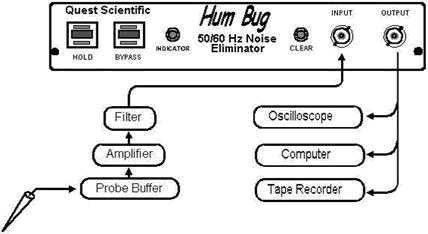
Hum Bug电噪音消除仪
产品名称: Hum Bug电噪音消除仪
英文名称:
产品编号: Hum Bug电噪音消除仪
产品价格: 0
产品产地: USA
品牌商标: Hum Bug
更新时间: null
使用范围: null
- 联系人 :
- 地址 : 成都市上东大街269号.新和•春禧时代12-11
- 邮编 : 610016
- 所在区域 : 四川
- 电话 : 136****7026; 132****0406 点击查看
- 传真 : 点击查看
- 邮箱 : ahmedicalus@gmail.com
Hum Bug电噪音消除仪
[ 作者:佚名 | 来源:本站原创 | 点击数:74 | 更新时间:2010-8-11 ]
Hum Bug 电噪音消除仪-ELIMINATE 50/60 Hz NOISE AND HARMONICS WITHOUT FILTERING!
AHMSIC Reasearch 2010 (Hum Bug Noise Eliminator).pdf
![]() AHMSIC Reasearch 2010 (Hum Bug Noise Eliminator).pdf
AHMSIC Reasearch 2010 (Hum Bug Noise Eliminator).pdf
A New Solution
Quest is proud to introduce the Hum Bug -- a new approach to Noise Control. This is a powerful new technology for cancelling electrical interference in real-time, avoiding all of the traditional problems associated with notch filters. The Hum Bug constructs a replica of noise present on the input signal and continuously subtracts this replica from the signal as it passes through the instrument. It performs this function in the presence of biological activity even when noise characteristics evolve over time.
Advantages
The Hum Bug is not a filter. It does not create phase delays, amplitude errors, DC shifts or waveform distortion. Simply connect it betweenyour preamplifier and any analysis equiment and it will automatically eliminate 50/60 Hz noise and harmonics with frequencies up to several kHz. Noise is eliminated without altering the signal of interest even when frequencies within the signal overlap with noise components. No settings or adjustments are required.
Eliminates Electrical Interference
Simple 50/60 Hz Sine Waves
Mixtures of 50/60 Hz Harmonics
Noise Spikes from Dimmers
Complex Noise from Flourescent Lamps
No Waveform Distortion
No Frequency Loss
No DC Voltage Shift
No Signal Attenuation
No Phase Error
一款非常好用的电噪音消除装置,能很好地搭配膜片钳等电生理记录设备使用
Hum Bug采用能够根据环境电噪音实时产生反相的电噪音,从而抵消环境噪音对输入信号的干扰,整个除噪过程无需滤波。
可以消除各种电噪音:
* 简单的50/60Hz正弦波形噪音
* 50/60Hz谐波混合噪音
* 调光器Spike噪音
* 荧光灯产生的复杂电噪音
不会对信号的波形产生任何影响:
* 没有频率损失
* 没有直流电压漂移
* 没有信号衰减
* 没有相位错误
Reference : Quest Scientific HumBug
--------------------------------------------------------------------------------
In the last 10 years, the list below includes a handful of papers by a few users of this unique device.
Keiko Ikeda, Tatsushi Onaka, Makoto Yamakado, Junichi Nakai, Tomo-o Ishikawa, Makoto M. Taketo, and Kiyoshi Kawakami Degeneration of the Amygdala/Piriform Cortex and Enhanced Fear/Anxiety Behaviors in Sodium Pump 2 Subunit (Atp1a2)-Deficient Mice. J. Neurosci., Jun 2003; 23: 4667 - 4676.
Oliver Behrend, Antje Brand, Christoph Kapfer, and Benedikt Grothe Auditory Response Properties in the Superior Paraolivary Nucleus of the Gerbil. J Neurophysiol, Jun 2002; 87: 2915 - 2928.
Sophia Kröther, Joachim Mogdans, and Horst Bleckmann Brainstem lateral line responses to sinusoidal wave stimuli in still and running water J. Exp. Biol., May 2002; 205: 1471 - 1484.
M.P. Burnham, R. Bychkov, M. Félétou, G.R. Richards, P.M. Vanhoutte, A.H. Weston, and G. Edwards Characterization of an apamin-sensitive small-conductance Ca2+-activated K+ channel in porcine coronary artery endothelium: relevance to EDHF. Br. J. Pharmacol., Mar 2002; 135: 1133 - 1143.
R. James Storer, Simon Akerman, and Peter J. Goadsby GABA receptors modulate trigeminovascular nociceptive neurotransmission in the trigeminocervical complex. Br. J. Pharmacol., Oct 2001; 134: 896 - 904.
Yukiori Goto and Patricio ODonnell Network Synchrony in the Nucleus Accumbens In Vivo. J. Neurosci., Jun 2001; 21: 4498 - 4504.
Marcello G. P. Rosa, Rowan Tweedale, and Guy N. Elston Visual Responses of Neurons in the Middle Temporal Area of New World Monkeys after Lesions of Striate Cortex. J. Neurosci., Jul 2000; 20: 5552 - 5563.
A.W. Henkel, H. Meiri, H. Horstmann, M. Lindau, and W. Almers Rhythmic opening and closing of vesicles during constitutive exo- and endocytosis in chromaffin cells. EMBO J., Jan 2000; 19: 84 - 93.
Thomas A. Macek, Hervé Schaffhauser, and P. Jeffrey Conn Protein Kinase C and A3 Adenosine Receptor Activation Inhibit Presynaptic Metabotropic Glutamate Receptor (mGluR) Function and Uncouple mGluRs from GTP-Binding Proteins. J. Neurosci., Aug 1998; 18: 6138 - 6146.
